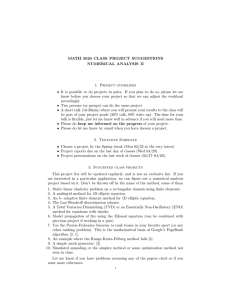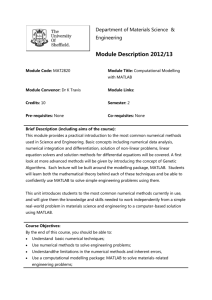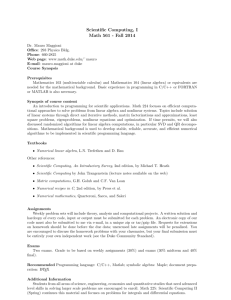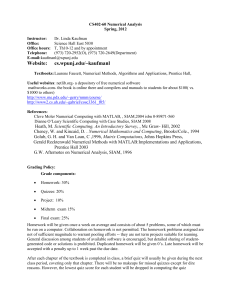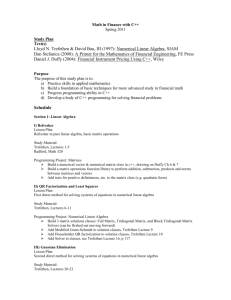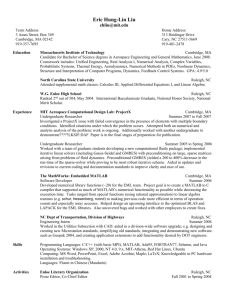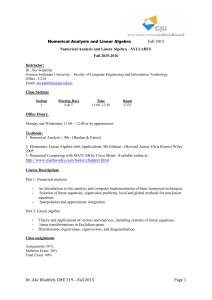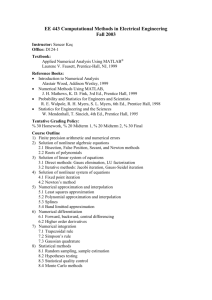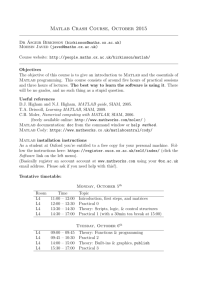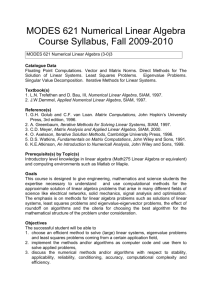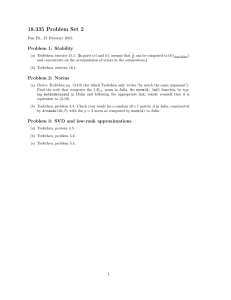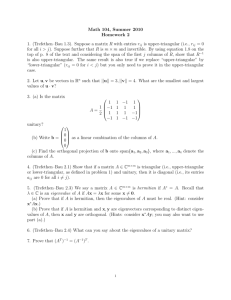Course green sheet (MS word doc file)
advertisement
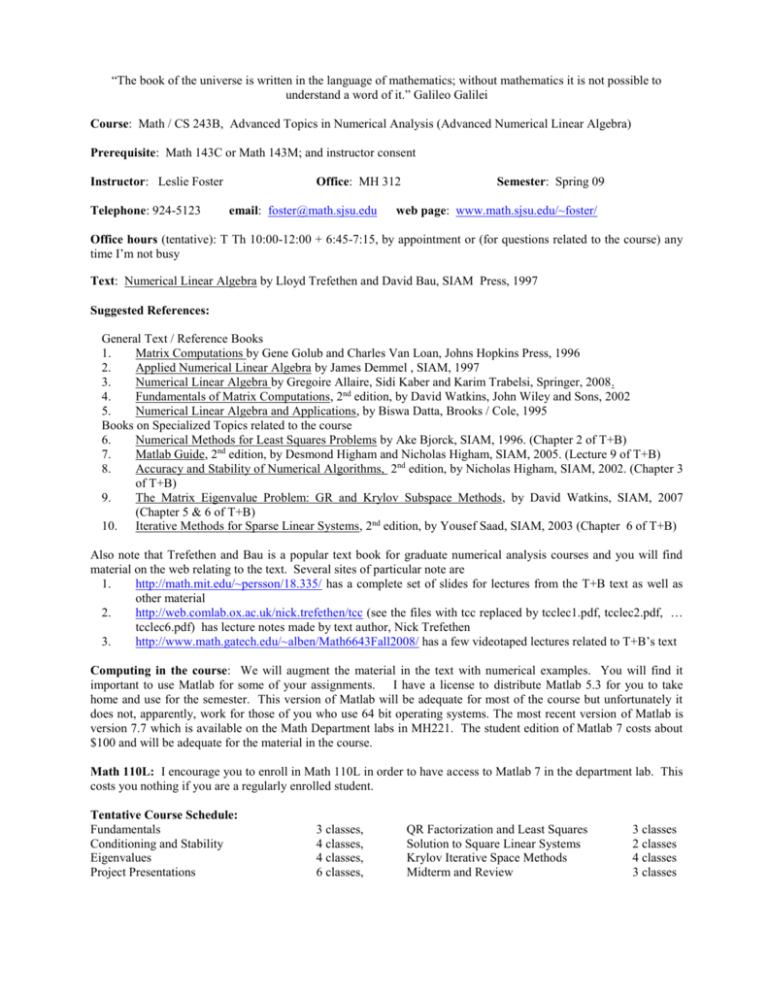
“The book of the universe is written in the language of mathematics; without mathematics it is not possible to understand a word of it.” Galileo Galilei Course: Math / CS 243B, Advanced Topics in Numerical Analysis (Advanced Numerical Linear Algebra) Prerequisite: Math 143C or Math 143M; and instructor consent Instructor: Leslie Foster Telephone: 924-5123 Office: MH 312 email: foster@math.sjsu.edu Semester: Spring 09 web page: www.math.sjsu.edu/~foster/ Office hours (tentative): T Th 10:00-12:00 + 6:45-7:15, by appointment or (for questions related to the course) any time I’m not busy Text: Numerical Linear Algebra by Lloyd Trefethen and David Bau, SIAM Press, 1997 Suggested References: General Text / Reference Books 1. Matrix Computations by Gene Golub and Charles Van Loan, Johns Hopkins Press, 1996 2. Applied Numerical Linear Algebra by James Demmel , SIAM, 1997 3. Numerical Linear Algebra by Gregoire Allaire, Sidi Kaber and Karim Trabelsi, Springer, 2008. 4. Fundamentals of Matrix Computations, 2nd edition, by David Watkins, John Wiley and Sons, 2002 5. Numerical Linear Algebra and Applications, by Biswa Datta, Brooks / Cole, 1995 Books on Specialized Topics related to the course 6. Numerical Methods for Least Squares Problems by Ake Bjorck, SIAM, 1996. (Chapter 2 of T+B) 7. Matlab Guide, 2nd edition, by Desmond Higham and Nicholas Higham, SIAM, 2005. (Lecture 9 of T+B) 8. Accuracy and Stability of Numerical Algorithms, 2nd edition, by Nicholas Higham, SIAM, 2002. (Chapter 3 of T+B) 9. The Matrix Eigenvalue Problem: GR and Krylov Subspace Methods, by David Watkins, SIAM, 2007 (Chapter 5 & 6 of T+B) 10. Iterative Methods for Sparse Linear Systems, 2nd edition, by Yousef Saad, SIAM, 2003 (Chapter 6 of T+B) Also note that Trefethen and Bau is a popular text book for graduate numerical analysis courses and you will find material on the web relating to the text. Several sites of particular note are 1. http://math.mit.edu/~persson/18.335/ has a complete set of slides for lectures from the T+B text as well as other material 2. http://web.comlab.ox.ac.uk/nick.trefethen/tcc (see the files with tcc replaced by tcclec1.pdf, tcclec2.pdf, … tcclec6.pdf) has lecture notes made by text author, Nick Trefethen 3. http://www.math.gatech.edu/~alben/Math6643Fall2008/ has a few videotaped lectures related to T+B’s text Computing in the course: We will augment the material in the text with numerical examples. You will find it important to use Matlab for some of your assignments. I have a license to distribute Matlab 5.3 for you to take home and use for the semester. This version of Matlab will be adequate for most of the course but unfortunately it does not, apparently, work for those of you who use 64 bit operating systems. The most recent version of Matlab is version 7.7 which is available on the Math Department labs in MH221. The student edition of Matlab 7 costs about $100 and will be adequate for the material in the course. Math 110L: I encourage you to enroll in Math 110L in order to have access to Matlab 7 in the department lab. This costs you nothing if you are a regularly enrolled student. Tentative Course Schedule: Fundamentals Conditioning and Stability Eigenvalues Project Presentations 3 classes, 4 classes, 4 classes, 6 classes, QR Factorization and Least Squares Solution to Square Linear Systems Krylov Iterative Space Methods Midterm and Review 3 classes 2 classes 4 classes 3 classes Project: I want part of the course to be a true seminar style class with student presentations. Therefore a project and presentation will be required. Learning Objectives: To understand the commonly used algorithms for the topics listed above. To be able to compare these algorithms in terms of efficiency, accuracy and reliability. To understand the derivations of the algorithms and the major theoretical results related to the algorithms, including their proofs. To develop the skills required to investigate a specific topic in depth and present the results of the investigation orally and in writing. Requirements and Points Midterm Final ~5 Assignments Project/Presenation Points Each 100 150 ~20 100 Basis of Grade Curve within reason. The curve for each individual test/assignment/project will be announced in class when the assignment is returned. If not announced the curve is 93/90/87/83/80/77/73/70/67/63/60 for A/A-/B+/B/B-/C+/C/C-/D+/D/D-. Total ~500 Make-up exams and quizzes: None except under very unusual circumstances and then only if you contact me (via phone, message, in person, note, ...) before the exam. Make-up exams will be more difficult. Cheating: Don’t. On homework assignments you may discuss the assignments with other students but don’t copy their work. Also you can find solutions to some of the homework problems from Trefethen and Bau’s text on the web. Doing homework problems by yourself or as part of a study group is the educational (and fun!) part of the homework. I much prefer that you work in this manner. If you or your study group gets help with a solution from the web cite the source!! Additional information / requirements please see http://www.math.sjsu.edu/math/courses/mathgs.htm
